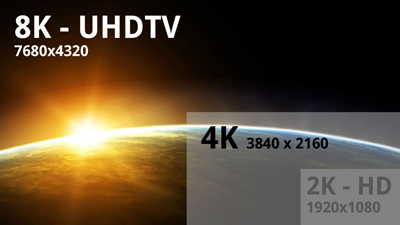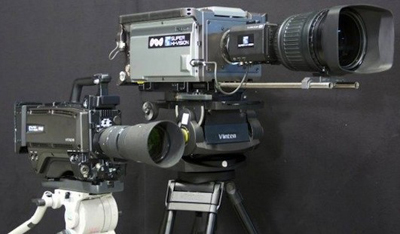8K Train Can't Be Stopped
TOKYO—While U.S. broadcasters are wrestling with how and when to utilize 4K (aka Ultra High Definition or UHDTV) in their production workflows, or if at all, the Japanese broadcast industry is determined to move to a higher resolution level, namely 8K. That's 16 times the resolution of 1080-line HD, or 7680 × 4320 (33.1 megapixels, 12-bit processing). Uncompressed, an 8K 60fps image produces a data rate of about 24 Gbps.
Japan's national broadcaster, NHK, plans to deploy equipment that complies with the bandwidth-hungry format at the Tokyo Olympics in 2020. In January of this year, NHK's science and research laboratories said it successfully transmitted 8K television signals via a single standard UHF terrestrial broadcast channel over a distance of 27 km. The field test, conducted on Jan. 20 was performed as a follow-up to a May 2012 demonstration in which the UHD signal was sent slightly more than four km.

8KTV could confuse the buying public, to the detriment of everyone involved. According to an NHK press release, this large amount of data generated was compressed and then transmitted in a 6 MHz broadcast channel using "ultra-multilevel" orthogonal frequency division multiplexing and multiple-input multiple-output dual-polarization technologies.
During a panel discussion at the recent BVE conference in London, Andy Quested, head of technology for HD & UHD TV at the BBC, said, "NHK sees the jump to 8K from HD as the leap to make, and sees 4K as a cheap European/US standard made to sell TV sets." He might be right in his assessment, but the challenges of implementing an 8K infrastructure to move these signals around a facility and then get it into consumer's home is daunting at best.
However, the Japanese—more specifically, NHK—have never been daunted by a technical broadcast challenge. NHK was the first to introduce analog HD ("Hi-Vision") commercially in the 1980s, and also showed prototype digital HD and 4K (called "Super Hi-Vision") transmissions before many others. NHK has reportedly been doing research into 8K technologies since 1995.
Many industry analysts feel even discussing 8K ("UHDTV-2") at a time when 4K is still in its infancy makes 4K a mere stepping stone to something better and could confuse consumers into not buying anything.
At the CES Show last year, Sharp showed a prototype 85-inch 8K LCD screen. At 7680 x 4320 pixels, the screen can display a 33 Megapixel image without any downscaling or cropping. The immersive image detail and brightness of the screen were astonishing to see, but many were asking, "Where's the content?"

NHK has significantly reduced the size of its 8K camera to make it more manageable for productions. While 4K content is limited, 8K content is virtually nonexistent. (The clips Sharp showed on the prototype were recorded by NHK.)
The 8K format is part of the ATSC's 3.0 broadcasting standard now being formalized and will be ready for initial testing in 2016.
NHK demonstrated real-time, over-the-air transmission and reception of 8K at last year's NAB Show and is expected to show improvements this year as well. NHK demonstrated real-time, over-the-air transmission and reception of 8K at last year’s NAB and is expected to show improvements this year as well. In fact, the Japanese public broadcaster will present the latest iteration of its Super Hi-Vision system, including a closed-circuit demonstration of over-the-air transmission of 8K content in a single 6 MHz UHF TV channel.
The demonstration will be presented at the NAB Labs Futures Park, in Las Vegas. This will be the first time anywhere in the world outside Japan that wireless transmission of 8K Super Hi-Vision has been demonstrated over a single 6 MHz TV channel. NHK will also present detailed results of a long-distance, single-channel, over-the-air 8K test broadcast recently conducted in Japan.
In addition, the NHK exhibit will feature a presentation theater with a 350-inch screen for viewing newly shot Super Hi-Vision content with 8K video projection and full 22.2-channel sound reproduction, including highlights from the Sochi Winter Olympic Games. NHK also promises to show an 8K video camera that weighs less than 4.5 lbs., the world's first 8K-capable real-time HEVC encoder, and an immersive sound system providing virtual representation of 22.2-channel sound for the home theater environment.
Also at the year's NAB Show, Ikegami (booth C7725) will host an 8K Technology Exhibit of its own, providing attendees with an up-close look at the latest advances in this extreme high-resolution format. The company said it will showcase several products that are compatible with 8K acquisition and transmission.
One benefit of 8K acquisition is that a perfect 4K image can be derived from it. The color fidelity and resolution of a full 8K image down-sampled to 4K appears to be phenomenal. Slow-motion replays will look more stunning than ever. As for other camera manufacturers, RED Digital Cinema has stated its cameras will record 8K in the near future. Sony reportedly down-samples its almost 8K sensor in-camera to 4K (since the resolution is reportedly 8768 x 2324, it could never record 8K in-camera).
For all those professionals trying to decide whether now is the time to buy a 4K camera, talk and testing of 8K systems is not doing anyone any favors.
The professional video industry's #1 source for news, trends and product and tech information. Sign up below.
